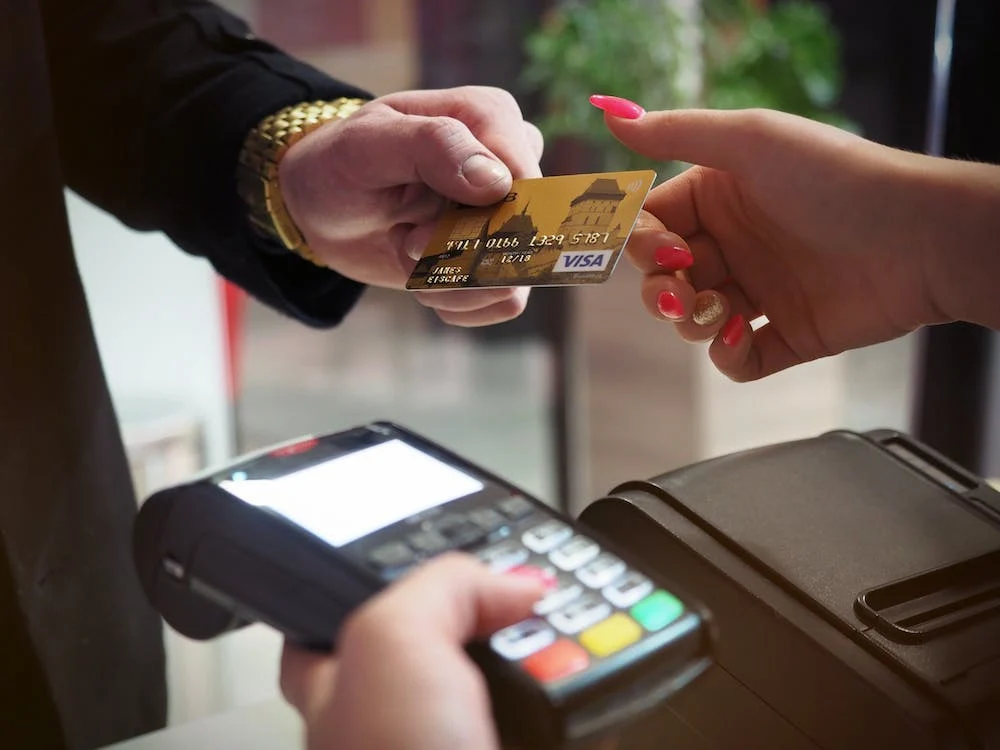Dropshipping has become a popular business model in the e-commerce industry. This approach allows entrepreneurs to sell products without holding any inventory. One crucial element for the success of a dropshipping store is the payment gateway. It acts as a bridge between the store and the customer, allowing smooth and secure transactions. In this article, we will explore the key considerations when choosing a payment gateway for dropshipping, how to select the best payment gateway, recommended options, and factors to consider when evaluating payment gateway combos for dropshipping.

What are the key considerations when choosing a payment gateway for dropshipping?
When selecting a payment gateway for dropshipping, several factors need to be taken into account to ensure a seamless and reliable payment process. One major consideration is the integration with dropshipping platforms. A payment gateway that seamlessly integrates with popular platforms such as Shopify and WooCommerce is essential for a smooth operational flow.
Additionally, a crucial consideration is the transaction fees and processing costs. As a dropshipper, it is vital to analyze the fee structures of different payment gateways to minimize costs and maximize profits. Furthermore, the accepted payment methods, including credit/debit cards, digital wallets, and other forms of online payments, play a significant role in catering to a wide range of customer preferences.
How to select the best payment gateway for dropshipping stores?
Choosing the best payment gateway for dropshipping stores requires a comprehensive understanding of your business needs. Each dropshipping business may have unique requirements, and it is essential to match those needs with the features and functionalities offered by the payment gateway. This includes evaluating factors such as multi-currency support, recurring billing options, and fraud prevention mechanisms.
Furthermore, comparing gateway features and functionalities is crucial in making an informed decision. The availability of robust security measures, user-friendly interfaces, and compatibility with various e-commerce platforms should be thoroughly examined. Moreover, examining customer support and service reliability plays an integral role in ensuring that any potential issues are promptly addressed by the payment gateway provider.
What are the recommended payment gateway options for dropshippers?
For dropshippers, it is crucial to explore payment gateway options that not only offer security and reliability but also align with the store’s operational requirements. One widely recognized payment gateway is PayPal, known for its versatility and widespread acceptance. Integrating PayPal as a payment method can offer convenience to customers and foster trust in the payment process.
Another recommended option is Shopify Payments, designed to seamlessly integrate with Shopify stores. This native payment gateway simplifies the transaction process for both merchants and customers, offering a seamless e-commerce experience. Additionally, various popular payment gateway providers tailored to the specific needs of dropshipping businesses are available, each with its unique set of features and benefits.
How to choose the best payment gateway for your dropshipping store?
When choosing the best payment gateway for your dropshipping store, it is essential to gain a comprehensive understanding of the payment process and options. This involves evaluating the various stages of the payment cycle, including authorization, capture, and settlement, to ensure a smooth and efficient transaction process for both the merchant and the customer.
Furthermore, evaluating the best payment processor for dropshipping is crucial in determining the most suitable solution for your business. Factors such as processing fees, compatibility with different e-commerce platforms, and ease of integration should be carefully assessed to make an informed decision. Additionally, utilizing payment gateway combinations, allowing multiple payment methods to be integrated into the store, can provide flexibility and convenience to customers.
What are the key factors when considering payment gateway combos for dropshipping?
When considering payment gateway combos for dropshipping, certain key factors should be prioritized to ensure an optimal payment experience for both the business and its customers. Enhanced security and fraud protection mechanisms should be a top priority to safeguard against potential threats and instill confidence in the payment process.
Moreover, offering a wide range of payment options to customers, including credit/debit cards, digital wallets, and alternative payment methods, can enhance the shopping experience and cater to diverse customer preferences. Lastly, ensuring a seamless checkout experience for dropshipping transactions is essential to minimize cart abandonment and facilitate smooth and efficient payments.
Here are some of the best payment gateway names in the game:
1. PayPal

PayPal is, perhaps, the biggest beast in the payment gateway jungle.
Indeed, Paypal is a giant payment gateway, which works as an advantage for vendors. It holds the promise of familiarity and trust among consumers; this is particularly important for small brands and companies that do not yet have widespread brand recognition and trust. Its name brand recognition will likely result in higher conversion rates. A whopping 305 million people use PayPal, and it is accepted in over 200 countries worldwide in 25 different currencies. It’s a tried-and-true gateway that is ideal for many types of e-commerce and dropshipping operations. PayPal also supports all major credit cards as well as debit cards, PayPal, Venmo, and PayPal credit.
It is worth noting PayPal has other options available to vendors including PayPal Payments Pro (a gateway option that doesn’t require purchasers to have a PayPal account), PayPal Payments Standard (a version of PayPal Payments Pro), and PayPal Express Checkout (allows users to purchase by using just their PayPal credentials).
PayPal is also widely used and available for integration for the majority of the e-commerce platforms in the market, such as:
- PayPal for WooCommerce (WordPress)
PayPal app for Shopify Stores
PayPal for BigCommerce
2. Stripe
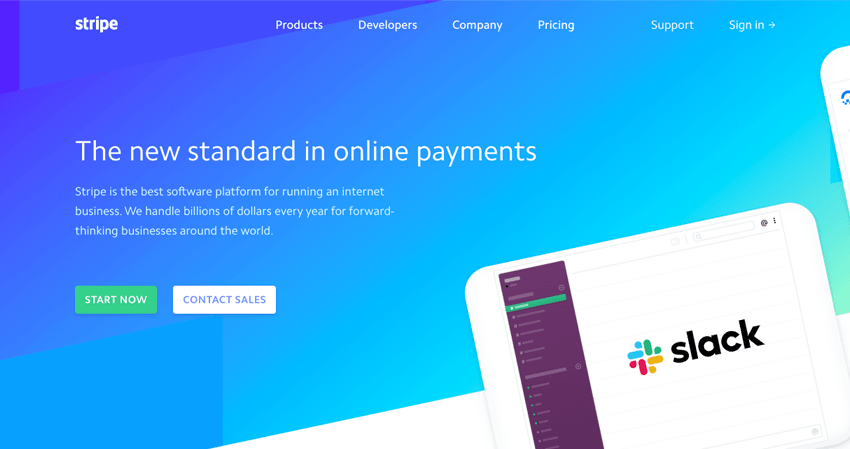
Call your tech department before choosing Stripe and, if you don’t have one, think about hiring one.
Another popular, global payment gateway is Stripe, which has fantastic customer support for vendors and increased flexibility in the form of more extensive developer tools. With a flexible API, you can customize the platform to your needs. An excellent choice for businesses with developers and tech specialists on hand, you can add a Stripe POS system to your brick-and-mortar store, bill your customers regularly and routinely, and complete one-time payments – whatever your business needs.
Vendors who choose to use Stripe also have the benefit of its many partnerships with the exceptionally high number of third-party platforms and tools that may improve your website experience.
3. Adyen
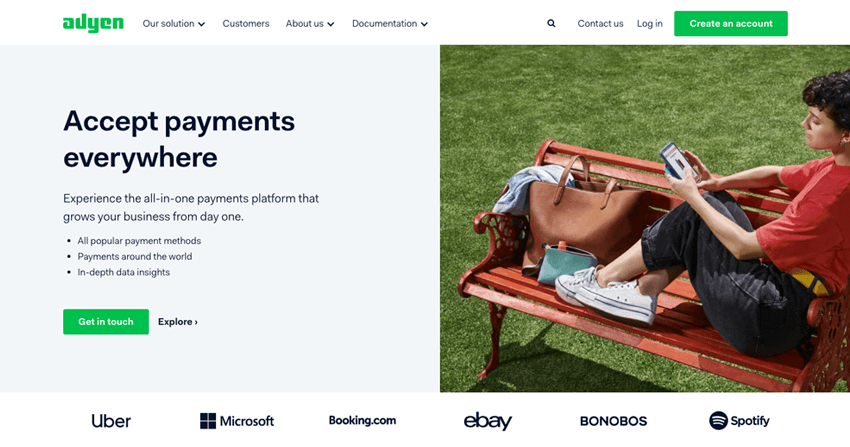
eBay moved its massive operation to Adyen back in 2018, and the payment gateway has only grown since then. Adyen accepts over 250 payment methods and 150 currencies from around the world and provides its users with in-depth customer analytics and insights. Its advantages speak for itself: conduct business efficiently and globally and use the detailed data to modify listings according to consumer behavior in real-time. Then, just watch your sales increase. The gateway is also designed to look out for vendors. There are integrated risk-management features that search and fight fraud. One of the only downsides? Its pricing model can get complicated, and that can be frustrating for vendors.
4. 2Checkout
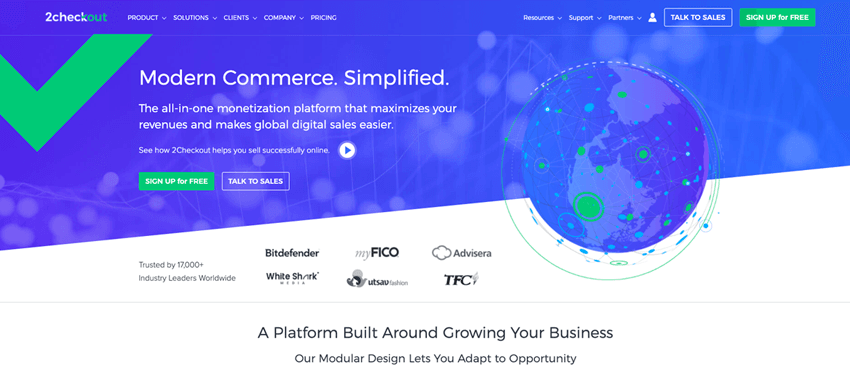
The U.S. based payment system brings two major critical cards to the table: excellent localization and the ability to integrate with other systems easily. 2Checkout simplifies transactions for customers by supporting different languages and currencies and accepting online and mobile payments. You cannot overestimate the value of simple, easy-to-use interfaces for consumers. In the same spirit of streamlining the eCommerce process, 2Checkout can combine with online shopping carts and invoicing systems to help you process your payments faster and easier.
In other words, 2Checkout will help you stay sane as much as it will grow your sales.
5. Vapulus
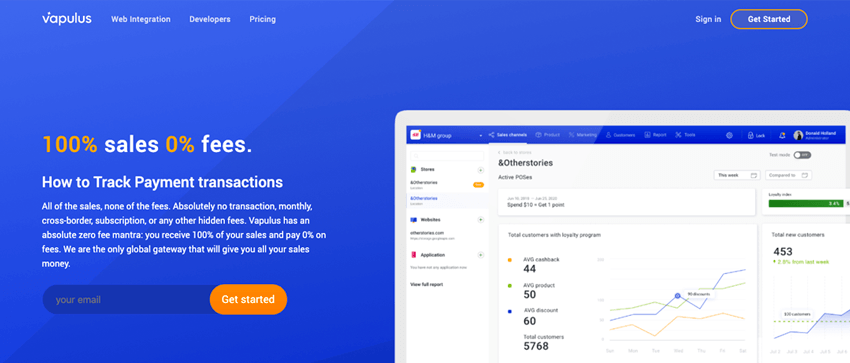
Everyone loves free stuff, even in the niche world of payment gateways. That’s one of the many reasons why we love Vapulus.
Vapulus is grounded in simplifying mobile payments, which is a considerable asset in a world of rising mobile shoppers. While it is a global platform, what sets Vapulus apart from the crowd is its commitment to charge vendors 0% fee, giving you 100% of your sales. Given its nonexistent fees and unique ability to send targeted customer perks and discounts, it is a fantastic option for small businesses. It will assist small brands in developing a loyal customer base and expanding their market presence domestically and internationally. It is a formidable competitor in terms of giving vendors a single interface with plenty of data that is easily analyzed.
6. PaySimple

The name says it all.
PaySimple is an incredibly functional platform that prioritizes product placement and marketing services to drive traffic and conversions via your website and social media. It boasts of endless flexibility with the ability to accept credit card and e-check payments across all sales avenues, including in person with a POS system, on the phone, and online. You can also utilize PaySimple’s sales and order data to generate standard and customized reports that will give you invaluable customer insights.
7. Dwolla
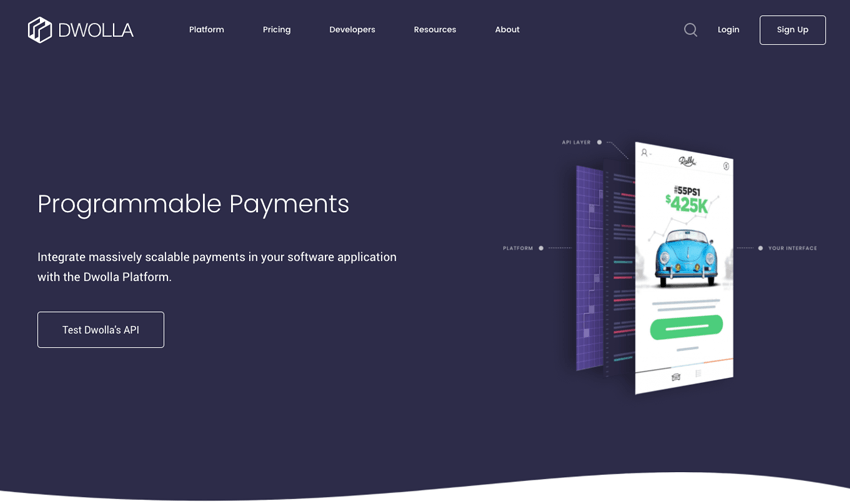
Dwolla might not be the right choice for traditional, product-based retail businesses, but it is a lifesaver gateway for businesses that rely on bank transfers to conduct sales. Dwolla is a scalable, flexible platform that works well with all United States banks and financial institutions. Much like Stripe, it is open-source software that permits developers to integrate bank transfers whatever company-specific tools needed.
8. Square
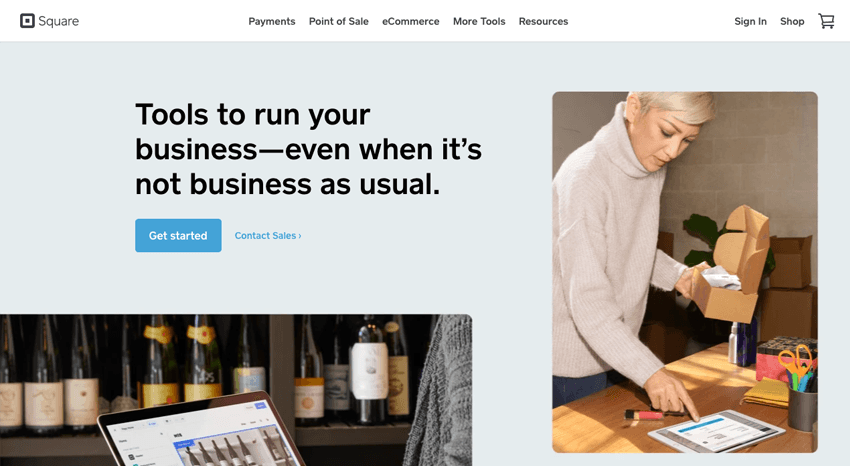
Square has gained more name brand recognition through high profile e-commerce partnerships with organizations like Wix, WooCommerce, WordPress, OpenCart, Magneto, and Ecwid. Known for its POS systems intended for brick-and-mortar locations and in-person payments, Square has expanded its gateway payment capabilities and become more and more of an asset for business owners. If part of your longterm business model includes plans for physical store locations, Square is a good investment in the future.
9. Payoneer

Payoneer empowers freelancers and small businesses to stake a claim in international markets. It offers an unparalleled mass payout system that makes the global workforce a much tighter, stronger, and more communicative network. Companies can hire and quickly pay contractors and freelancers from all over the world, regardless of where they operate. Payoneer enhances its payout platform by supporting over 35 languages, which makes the localization process a breeze.
How to Choose the Best Payment Methods for your Online Store:
The most important thing to remember when selecting a payment gateway for your eCommerce or drop shipping platform is that there isn’t a one-size-fits-all solution. Consider all facets of your operations, short-term and long-term goals, and current weaknesses that your payment system might be able to improve.
Ask yourself many questions during the selection process:
- Can a payment gateway grow and evolve as your business does? Are you planning on expanding into new markets? If so, prioritize a payment platform that excels at localizing transactions for international customers.
- Is there ample customer support for you as a vendor? Business owners must get the help they need so that their technology works with them, not against them.
- How much does it cost, and how are the payments structured? For larger businesses, smaller monthly subscription fees are more financially viable than more substantial transactional fees, whereas the opposite is true for individuals and small businesses.
- Who owns your customers’ data, and how secure is your payment gateway? Security, trust, and transparency mean everything to consumers.
- How widely used and understood is the payment system in your core market? Tailor your eCommerce and drop shipping experience to your loyal customer base first, and expand into new markets second.
- Does your platform work well with your payment system of choice? Not all eCommerce platforms accept all payment gateways. Verify that your gateway of choice is compatible with your eCommerce or drop shipping platform.
Part of figuring out the most logical and seamless solution for your business means considering a combination of several payment platform providers and being open to some experimentation, particularly with dropshipping. Many of the gateways here will combine beautifully with each other as well as with digital wallets like Apple Pay, Google Pay, and Android Pay.

With much of the world toting iPhones around and talking into their Apple watches, looking into Apple Pay as an integration or your e-commerce or dropship platform makes financial sense if you think a combination of integrations is the right route for your business. Much like Amazon, Apple’s reputation for simplicity and solid design precedes it, and billions of people already have Apple accounts and money sitting in their Apple Pay.
Whew, you’ve made it. Congrats! You’ve got a lot to consider, but just remember that there’s plenty of room for experimentation. Don’t be afraid to try a certain gateway solution and then pivot if it isn’t serving your business well. You know your business better than anyone else does.
While it can be overwhelming, there’s never been a better time to be in eCommerce or dropshipping. The resources and technologies emerging in the business landscape right now reflect the 21st-century consumer priorities; they recognize the importance of an intuitive, localized customer buying experience and the rising dependence on mobile-based shopping. With some experimentation, analytics, and a solid understanding of your company framework, you’ll be able to harness today’s technologies into an individualized payment system solution that will improve your sales numbers and customer engagement.

